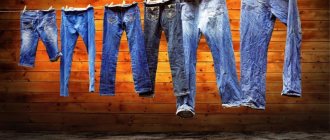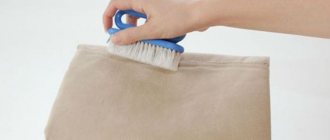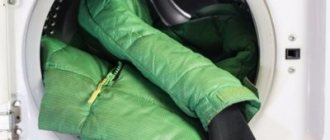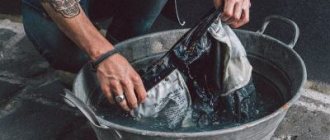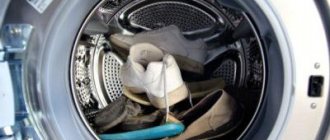Each of us has at least one pair of jeans in our closet. We love them because they are comfortable, practical and flatter your figure. If we want them to look like new, we must know how to wash jeans in the washing machine and by hand. Here are tips to help keep your favorite denim pants looking great for years to come.
How to wash jeans - a practical guide
Denim pants are a piece of clothing that doesn't like to be washed too often. Choosing the wrong mode or temperature in the washing machine can lead to destruction of the fabric. You also need to be careful with drying and ironing. So how should we cherish denim?
Some methods of how to properly wash jeans may be surprising, but only such processing of the material will keep the color and shape intact. We will tell you what to do so that your trouser legs do not stretch, do not fade, and always lie well and flow down your legs.
Optimal mode, temperature, powders
Manufacturers always give recommendations regarding washing various products. Carefully study what is written on the label. The icons on the label will help you understand the most important issues:
- at what temperature are jeans washed?
- how to do push-ups correctly;
- what powders and liquid detergents are best to use.
Let's look at the important issues in more detail.
Temperature is important
Thirty degrees is the optimal temperature. Don't forget to select a gentle spin with speeds up to 800.
The most gentle modes:
- "Jeans". Relatively new mode. Only the most modern units can boast of its presence. Ideal for washing any denim.
- "Handwash". Provides the most gentle cleaning of pants at partial speed. Almost everyone has them in their cars. No less suitable option for denim. Don't forget to set the desired temperature.
- "Express wash" The best solution for pants that don't get too dirty. The mode has its advantages: jeans are washed at low temperatures and are in direct contact with water for a short time - from 15 to 30 minutes. Use the express mode to prevent them from sitting down.
Suitable chemistry
Choosing the optimal detergent is a crucial step. The optimal choice is liquid formulations. They perfectly wash stubborn stains and at the same time can be easily rinsed from synthetic and natural fabrics and do not leave streaks.
The best solution are gels for jeans:
- Bagi Jeans. A popular product made in Europe. Indicated for cleaning denim. The composition not only perfectly removes dirt, but also softens hard fabrics.
- BiMax Jeans. Domestic product. Allows you to clean not only jeans, but also sportswear.
- Domal Jeans. Concentrate from Germany. Does not wash out paint from fabric. Allows you to preserve the color of jeans for a long time.
- Dreft Black. The liquid composition is used when cleaning black fabrics. Ideal for machine processing of black denim.
Automatic loose powders for color are also suitable. The main thing is that they should not contain bleaches. Otherwise, the jeans may radically change their color and not for the better.
Is the pair made of rigid denim? Don't forget to add some conditioner. It will soften the fabric and make the product more pleasant to the touch.
Do I need to wash jeans after purchase?
According to experts, you should wait to wash the jeans you just purchased in the washing machine. Give them time to lie on the body, and only after that we will wash them.
Sometimes the process of adjusting trousers to your figure can take up to several months and they can become dirty. Then we won’t delay the washing, but wash it by hand for the first time.
To protect the color, before the first wash, soak your pants in cold water with salt and vinegar. We immediately turn them inside out: thanks to this, the material (especially dark ones) will not lose color, and white lines will not form on the folds.
It is imperative to fasten the zippers and buttons so that the material is not accidentally damaged.
Of course, don't forget to empty all your pockets : even a small handkerchief can leave thousands of white stains on your clothes. What if there is lipstick or a pen in your pocket?
Main
- Jeans can be washed in a machine. But it is important to follow the rules: turn the item inside out, use cold water and fast wash cycles, do not wring out and dry naturally.
- It is better to wash jeans separately from other items or only with clothes made of similar fabric of the same color.
- Use special detergents for washing jeans and sportswear to preserve their color. They are more economical and more effective than conventional powders.
- Remove difficult stains with a mixture of soda and salt, hydrogen peroxide or ammonia.
- Fabric softener or 9% vinegar will help return things to softness.
At what degrees should you wash jeans?
Denim is a capricious fabric, although it is considered a working fabric. He definitely doesn't like being washed in hot water. High temperatures are hard on cotton fibers, causing them to shrink. In addition, washing colored clothes at 60 degrees leads to shedding and shrinkage. And this, in turn, affects the texture and fit of the figure.
Denim trousers, like other items made from this material, should be washed at a temperature not exceeding 30 degrees. If it seems to us that clothes are washed better at high temperatures, this is a mistake. It all depends on the right cleaning products.
Types of denim fabrics
The fabric is distinguished by its composition, technology of weaving threads, and method of dyeing. The type of denim fabric determines the quality and service life of the finished product.
Classification:
- Denim. Classic durable smooth fabric. Formed by weaving two-color fibers based on extra long cotton. The warp threads are blue, the weft threads are bleached and undyed. The reverse side is much lighter than the front side. Indigo dye does not penetrate into the fibers and is deposited on the surface. The material is not picky to care for, but during washing the dye is gradually washed out and the jeans lighten.
- Broken twill, twill. Fabric with a characteristic right- and left-hand twill weave. Reminiscent of a herringbone pattern on the diagonal of the canvas. Varies in thickness and thread density. Broken lines form a dense texture that will last for many years. Original Wrangler models are constructed from twill.
- Stretch, lycra. Cotton fabric with synthetic fibers. More often, manufacturers use elastane, less often - Chinese nettle ramie. The denim fabric stretches and shapes your figure. The material is difficult to wash. Improper care leads to shrinkage and loss of elastic properties.
- Gin. Plain blue cotton fabric. Made from cheap cotton. Major global brands use gin in the most budget models. Requires delicate handling.
- Chambry. Lightweight, thin melange cotton fabric. The threads are intertwined without displacement, at right angles. The basis of laconic, easy-to-wear items: shirts, tunics, dresses.
- Eikru (ecru). Untreated cotton, linen material made from undyed yarn. The color depends on the type, quality of the fiber, and manufacturing technology.
It is customary to distinguish between sanforized and raw denim. Processing using sanforization technology reduces shrinkage and shedding due to maximum leaching of the dye.
Rigid denim without factory processing during the first treatment intensively loses indigo and shrinks in size.
How to wash jeans correctly
Don't wash denim too often, it doesn't like it and doesn't require it. If your jeans are dirty or stained, of course you will have to wash them. But remember that denim does not like frequent washing. However, this applies more to the “raw denim” material from which branded jeans are made. Such trousers have a uniform color, are free from artificial abrasions, and natural ones are formed during subsequent stages of wear.
We can wash regular jeans regularly. As soon as we need to do this, we immediately remember the low temperature and select a mode with a low number of revolutions. The ideal program is delicate wash.
It is advisable not to wash other clothes with jeans. This is especially true for black or dyed items, which can ruin your favorite pants forever.
Do I need to turn it inside out?
Jeans must be turned inside out before washing.
There are several reasons for this:
- Color preservation. The less the outer surface of the pants rubs against the drum, the brighter and more saturated the color of the jeans will be.
- Safety of zippers , fasteners and other accessories.
- Preservation of the product's shape. When turned inside out, jeans deform and shrink less.
There is no need to turn the product right side out while drying. This will prevent dust and other contaminants from settling on it. How to get rid of stains
If the stains are fresh, regular washing powder can handle them. To save an item from dirt deeply embedded in the fibers of the fabric, you can use salt and ammonia . These products are dissolved in warm water and then washed.
It has been noted that modern stain removers (like Vanish, Antipyatnin soap) deal with stains by pouring small quantities onto the contaminated area, washing it, and then putting the items in the washing machine.
The right detergents for jeans
The texture of jeans is very susceptible to deformation, so you should avoid using any bleaches or bleaching washing powders. You can wash your favorite denim trousers with special detergents for dark fabrics. Their advantage is that they do not leave a white residue and also prevent pigment loss.
When washing denim, do not add softener. Its action can disrupt the structure of the material.
If your dirty jeans have been left wet for too long before being washed in the washing machine, causing them to become moldy, you can place them in a bowl filled with water and baking soda. This way you will get rid of the unpleasant odor. But you can remove the smell from the refrigerator in other ways.
If you need to soak your pants, remember, no more than 2-3 hours. This is especially important when it comes to navy blue.
Daily care
It is better to wash white jeans by hand to ensure maximum gentle care. Washing in an automatic machine is possible, but under certain conditions. First of all, we take care of preparing the pants for washing in advance:
- check pockets for forgotten items;
- turn a thing inside out;
- close all zippers and pockets;
- check whether the decorative inserts are sewn well;
- treat local stains and dirt with a stain remover;
- place the item in a protective mesh bag;
- load the bag of jeans into the drum;
- bring things to a minimum weight;
- add a suitable detergent to the powder receptacle (ideally a special gel designed for washing white jeans, or a triple-action gel capsule).
If the jeans have glued decor, rhinestones, or buttons, then machine washing is contraindicated - soapy water will wash away the glue and the elements will fall off.
Having loaded the machine, we proceed to setting up the cycle. We turn on the “Delicate” or “Manual” program and check the set parameters. The water heating should be set to 30-40 degrees, and the spin should drop to a minimum, 600-800. It is better to rinse twice so that all the washing gel is removed from the denim fibers. At the end of the program, carefully remove the jeans from the drum and dry them in a ventilated area. Machine drying is prohibited, as is exposure to direct ultraviolet light.
An alternative to washing jeans is the freezer
Manufacturers of branded jeans suggest that this type of trousers should not be washed frequently in a washing machine, but if possible, clean the fabric with a gentle product using a brush.
And our life hackers recommend wrapping denim pants in foil and then putting them in the freezer for several hours! They believe that low temperatures kill germs, thus refreshing the smell of clothes. This is a rather radical method, and not everyone is ready to use it. And you won’t be able to remove stains. Only proper washing will help keep your favorite jeans beautiful and clean for several months.
Changing jeans size
We use all the tips in reverse to reduce stretched jeans. Tricks will also come in handy for those who have lost weight by 1-2 sizes, but do not yet have the opportunity to update their wardrobe.
Shrinkage
Wash your jeans in a machine at 60 or even 90 degrees. The more cotton in the composition, the higher the likelihood of shrinkage. A radical method is boiling in a saucepan, but this is only suitable for the most durable denim.
Stretching
To stretch pant legs, work with the fabric while it is wet. Simply secure the waistband and give the bottom a good tug. Leave to dry in this position, you can additionally secure the pant legs.
Another way is to steam your jeans well and put them on yourself.
How to dry jeans
As with high-temperature washes, denim doesn't like the heat once it comes out of the washing machine. It is best to let the jeans dry naturally. They should not be hung on or near a radiator, and drying in the sun should be avoided. Try not to pull your pants up through the cord. It is better to dry them on a hanger, securing them to your belt with plastic clothespins. To prevent wrinkles, before hanging, you need to smooth the material with your palm and shake off the washed clothes.
Using an iron is also not advisable, as it can leave unsightly shiny marks on your jeans. If you want to protect your pants from fading, leave them inside out while drying or iron them wet only on the inside out through the fabric. This way, you can enjoy your favorite jeans for a long time if you wash them correctly.
Important Tips
To make washing your jeans as effective as possible, you must use the following recommendations:
- Do not ignore the manufacturer's advice. They are indicated on the product label. It is always on the wrong side of the jeans.
- Do not actively rub dirt on your jeans with a brush. This will cause stains.
- The fibers of the fabric will become fuzzy, which will affect the appearance of the product.
- The powder must be dosed strictly. Its excess will remain in the fibers of the fabric, which will require additional rinsing of the item.
If creases in the form of white stripes appear on your pants during drying, you need to moisten them with water and wait until they dry again.
